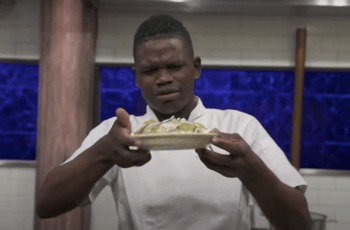Strategies to Help Guide Executive Function in Our Students
I love the show Chopped. In this reality show meets cooking competition, chefs compete and turn baskets of mystery ingredients into a three-course meal. In an episode called “Seeking a Sous Chef: Battle 2,” contestants had 30 minutes to create an entree from Aloo toast sandwiches, oca, a whole chicken, and ground bean sauce.

As one contestant opens the basket to reveal the Aloo toast sandwiches, he says, “What is this?” and laughs.
Every episode goes a little like this: contestants open the basket and the timer starts ticking. They have to create a vision/goal for their meal, define a strategy, find all the necessary supplies and ingredients and hope nothing goes wrong, which it always does. In Seeking a Sous Chef: Battle 2, contestant Shine Ou Yang sets out to prepare an aloo toast buttermilk fried chicken with an oca slaw.
With 20 minutes remaining, Shine said, “I am marinating my chicken, and I just realized I don’t have flour in the flour bags.” Someone else takes over the deep fryer when she walks away to get the flour. In a split second, she realizes she has to pivot and fry them in a shallow pan. When the deep fryer opens, she pivots again, pulling the chicken out of the oil and submerging it in the deep fryer.
The judges taste the food and note, “The piece of chicken that I have here is overcooked. It’s really brown. It’s too brown. This goes back to our initial commentary of making correct choices in the very beginning so you’re not later reacting to your initial choices.”
As I watch Chopped, I imagine a tiny air traffic controller in the chefs’ brains, focusing on the goal while monitoring progress and changing the strategy based on the context. They can do it, thanks to executive functions.
What are Executive Functions?
At the highest level of the human capacity to act skillfully are the so-called “executive functions.” Associated with networks that include the prefrontal cortex, these capabilities allow humans to overcome impulsive, short-term reactions to their environment and instead to set long-term goals, plan effective strategies for reaching those goals, monitor their progress, and modify strategies as needed. In short, they allow learners to take advantage of their environment. (CAST)
Reflect on that definition through the lens of the show, Chopped. Chefs must remember the goal, pay attention to their surroundings, and continue moving forward despite the stress and cognitive dissonance. These chefs have been training for years and are used to the fast pace of kitchens, and they still struggle to self-regulate. Teaching students these skills as early as possible and supporting them to practice them within a safe classroom community will help them build their executive functioning muscles, which they will need regardless of their life paths.
In an article in ADDititude Magazine, Huberty and Bechard (2022) stress the importance of executive function. They note, “Executive function is not necessarily a household term, yet each one of us depends on these functions to lead a productive, organized life. To no one’s surprise, school is where our executive function skills are first tested and refined. They often unlock — or preclude — success in the classroom.”
Executive functions, therefore, becomes a responsibility of educators. This is critical because “When educators assist students with identifying their executive functioning strengths and areas of need, they also teach them how to advocate for their own needs in the classroom and beyond” (Huberty and Bechard, 2022). So, where do you start?
Strategies to Support Executive Functions
UDL provides teachers with a set of strategies to support the development of executive functions within a rigorous curriculum. There are four checkpoints under executive function guidelines: each area is critical for success on Chopped, in school, and in life.
- Guide appropriate goal-setting (checkpoint 6.1)
- Support planning and strategy development (checkpoint 6.2)
- Facilitate managing information and resources (checkpoint 6.3)
- Enhance capacity for monitoring progress (checkpoint 6.4)
So, with these areas in mind, there are many things that we can do in the classroom to help develop executive functions in our students regardless of their age or variability.
Guide Appropriate Goal-Setting
- Give students sentence starters, graphic organizers, anchor charts and other scaffolds and resources to help your students gauge the effort needed, the resources they can use and the difficulty of the assignment
- Connect students to examples and models that show the process that needs to be done or the objective of the lesson
- Use checklists and guides to help students manage the process and set their own goals for the lesson
- Make the goals for the lesson, objectives and schedules visible in the classroom, in your LMS, throughout your instruction, and on any content that you distribute to your students
- Help students manage their time by showing them how you manage your time and remind them to celebrate the incremental deadlines they achieve and the projects they complete. Setting a timer is very helpful for some students (consider using the timer on your phone or download an app like Brili Routines)
Support Planning and Strategy Development
- Use age-appropriate, short and precise directions:
- Review information before adding new information
- Use Metacognition
- Offer visuals
- Remind students to take their time, stop and think and discuss their plans with you or a peer
- Provide space in your classroom for students for students to find a workplace that suits their needs
- Add prompts around the room, in your handouts and on the activities for the students to show and explain their work
- Share checklists, templates or graphic organizers to help students understand, prioritize,sequence and complete the activities
- Model the behaviors that you use by thinking out loud and working through a problem
- Work with students on how they can break down long term goals into manageable short term goals
Facilitate Managing Information and Resources:
- Use graphic organizers and templates to show students how to collect data and organize information and give them the opportunity to practice before grading.
- Show students how to categorize information and systematize the process and remind them often with prompts and additional
- Teach students how to block their time and reward themselves for meeting mini-deadlines
- Provide checklists and guides for note-taking (CAST)
- Model and use various strategies to problem solve:
- Use a gradual release approach
- Give students practice understanding their strengths and area of need
- Provide tools for students to visual plan and prioritize
Enhance Capacity for Monitoring Progress
- Ask questions to guide self-monitoring and reflection
- Show before and after photos, graphs and charts showing progress over time
- Ask learners to tell you the type of feedback or advice that they want or need
- Ask students to self-reflect on how they are doing or how they completed an assignment
- Provide options for self-assessment strategies (e.g., role-playing, video reviews, peer feedback)
- Show varied examples of completed student work with your comments and notes for improvement or celebration
- Use checklists, and rubrics for assessments multiple examples of annotated student work/performance examples
- Consider how often you, and student peers, will provide mastery-oriented feedback so no one can get too far off track
The list of support is extensive, and as with anything we do in school, not every student will respond to every support you offer, so it is important to develop a wide range of supports so that you can reach the most students and present them in a universally designed fashion. And hopefully, the more they reflect on feedback and use the tools available, the more they can grow. And as the judges on Chopped note, “Making correct choices in the very beginning” and continuing to reflect is the best way to experience success.
References
Novak, Katie (2022). UDL Now! A Teacher’s Guide to Applying Universal Design for Learning. 3rd Edition. CAST Publishing https://www.novakeducation.com/udl-now
CAST (2018). Universal Design for Learning Guidelines version 2.2. Retrieved from http://udlguidelines.cast.org
Huberty, K., & Bechard, M. (2020, June 15). The educator’s guide to executive functions: How to understand and support students in need. ADDitude. https://www.additudemag.com/executive-functioning-adhd-teacher-guide/
McGlynn, K., & Kelly, J. (2020). Executive functioning and success in the classroom. Science Scope, 43(7), 50–55. https://doi.org/10.2307/27048050
Mindprint. (2022). Cognitive skills. https://www.mindprintlearning.com/assessment#cognitive_skills
Morin, A. (n.d.). Classroom accommodations for executive function challenges. https://www.understood.org/en/articles/at-a-glance-classroom-accommodations-for-executive-functioning-issues


